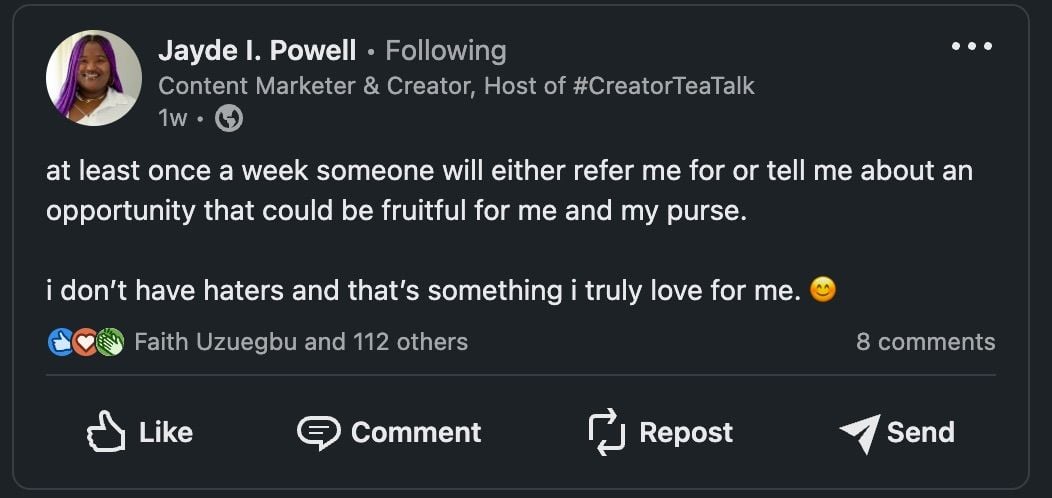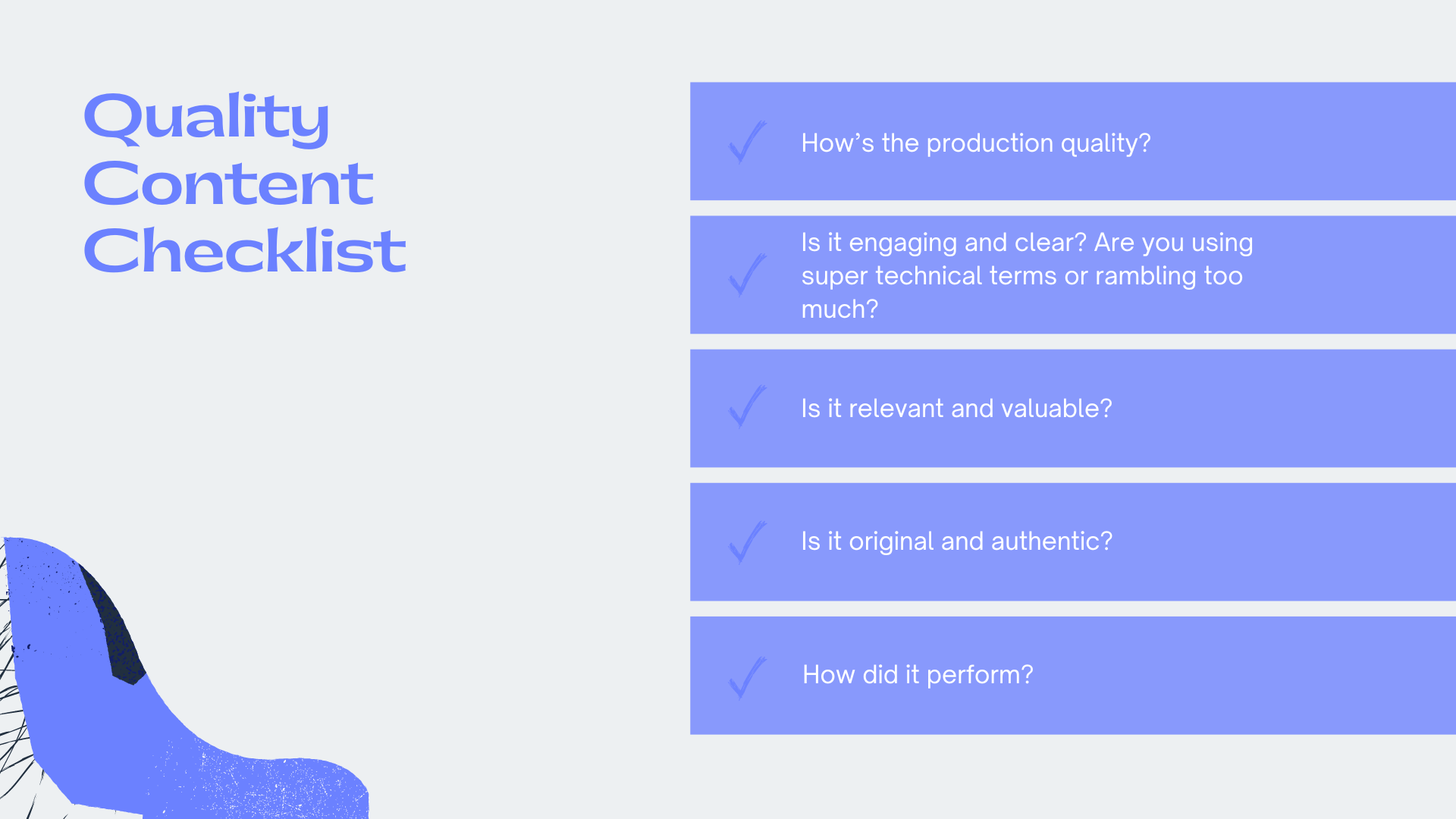🤔
Question: I want to improve the quality of my social media content, but the most popular advice is to create high-quality content to satisfy Google and other search engines. What advice do you have for consistently generating high-quality content for social media? Or better yet, how do I improve the quality of my content?
This is a question I often have to ask myself: how do I create (and improve) high-quality content? You may have been a creator for a while already, but you find yourself looking at creators you admire and seeing a gap between their content quality and yours.
There are too many ways to define “quality content,” even with the caveat that we focus on social media, so I understand your dilemma. So we won’t give you a step-by-step guide to creating quality content.
Instead, in this article, we’ll offer guidelines and advice to help you treat your content more intentionally, to deliver better value, and satisfy your creative desires.
What is high-quality content?
High-quality content, in the simplest terms (and within the context of our advice and your situation), serves an audience’s needs. It:
- Gets your audience’s attention
- Keeps them engaged, whether by watching or scrolling to the end
- Makes them excited for more
Why? With so many options for media consumption, most people are more selective than ever about what they spend their time on. If you offer quality content, you remove one barrier to winning them over.
So, how do you ensure you create high-quality content that gets and keeps your audience’s attention?
How do you create high-quality content?
High-quality content, regardless of platform, audience, or format, should inspire two things in your audience:
- a feeling (enlightenment, happiness)
- and an action (commenting to know more, bookmarking for a future date).
If you make a funny video, does it make people laugh? If you explained a complex concept in simpler terms, are the comments raving about how they’ve been enlightened? If it’s a personal story about how you learned a skill, did people ask further questions?
If this happens for you already, great – you’re on the right track! If not, you’ll need to take content creation a little further than coming up with ideas and posting. That doesn’t mean removing all the spontaneity and fun from the process – instead, having a system that helps you consistently create content that resonates with your audience.
We put together five guidelines to consider as you create content before you start working with a system, in order of how they’ll affect your audience’s journey with your content:
- How’s the production quality?
Production is the most technical part of your creative process but the simplest thing to get right. Whether you’re writing a blog post, recording a podcast, or filming a video, ensure that the technical aspects, such as audio quality, visuals, and editing, are top-notch. Maintain a consistent style, tone, and quality across all your content pieces. This enhances brand recognition and sets a standard for your audience’s expectations.
- Is it engaging and clear?
Engaging people is more important than ever, and hooks have emerged as the answer. Hooks refer to the first few lines (or seconds) of your content that grab the audience’s attention and get them to stick around.
@jacksonstips Try these on new videos and redo old ones #tiktoktips #contentcreation #smallbusiness #growyoursocial #entrepreneurtok #contentschedule #greenscreen
It’s also important to consider what will happen after you hook your audience. Your content needs to be easily digestible because unless they come looking for you specifically, they’ll move on if they aren’t getting what they need.
If your content is educational, avoid overly complex language and get to the point. If it’s entertaining, use sharp editing and the available features on your chosen social media platform. Your goal should be to get them to break up the monotony of a static video, image, or text.
- Is it relevant and valuable?
Your content should serve as a solution or answer to your specific audience’s needs, which can even become your niche. An example of an audience need is “a humorous and transparent approach to recruitment,” like Adam Karpiak on LinkedIn.
A quick tip for determining your audience’s needs is to pay attention to common questions and address them from your perspective. For example, if you want to create recruitment-focused content, you don’t have to go the humor route – simply adding personal anecdotes adds a human element to your content, making it more relatable and trustworthy.
- Is it original and authentic?
It’s easy to fall into the trap of repeating what’s already out there. This trap is more than just jumping on the latest trend. It also shows up in trying to write like everyone else on Twitter or making videos the same length as the most successful YouTube creators. However, your unique experiences are what set you apart.

Jayde Powell is all too familiar with the struggle of needing to “fit in” on social media, but she’s stuck to her authentic voice, and it’s won her an audience of loyal followers. Authenticity is magnetic. Create content that genuinely reflects you, even if it goes against the grain.
Think beyond metrics like likes or retweets when looking at your content’s performance. If an Instagram post got 50 likes and a Reel got 500, but you also got more questions and ideas from the post, that’s more value for you quality-wise.
Look at content performance as how your audience responded and let that play a role in what you create next. Better yet, encourage your audience to provide feedback within your content. Constructive criticism can be a goldmine for improvement.

Use these guidelines to evaluate content performance by taking five minutes to tick off each box.
4 tips to help you create high-quality content
Now that you know what to look for in your content to ensure it’s high-quality, here are some tips to help you consistently produce.
Set a foundation by planning content in advance
If you’re anything like me, you forget to do things if they aren’t on your calendar or a checklist. I use many tools to ensure I plan and schedule content in advance so I don’t forget.
Even if you have a mind like a steel trap and never forget anything, make your process more efficient with advanced planning to streamline the creation process. There’s no better way to plan than with a content calendar.
The right tool will help you track your ideas, set deadlines, and even figure out where to repurpose content. Platforms like Notion, Trello, Asana, or even plain old Google Sheets are excellent for outlining a content calendar. Some ideas of what to put in your content calendar:
- Idea – what are you publishing?
- Format – what type of content is it?
- Platform – where will you publish?
- Distribution – if you’re creating a big piece of content like a long-form article, you might want to plan out how you’ll promote it
- [Optional] Sponsorship opportunities – if you work with sponsors or want to pitch to sponsors, this would be helpful to note
Of course, planning only works if you already have ideas. Whether making timely or evergreen content, you need research to get ideas.
Set aside time for research and knowledge gathering
Whether you create evergreen (always relevant) or timely content, you must incorporate knowledge gathering in your content creation process. What are people asking about your chosen topic or industry? What is your competition doing? What trends are most popular right now?
Platforms and audiences change rapidly, and the only way to keep up is to stay on the pulse of the trends, insights, and innovations that are relevant to you. Even if your niche is “Day in the Life” TikToks from Alaska, the ability to frame age-old concepts through a modern lens is invaluable. Here are some ways to do that:
- Dedicate time to research: Allocate specific hours or days for in-depth research. This commitment ensures you delve deep into topics, offering your audience fresh and insightful perspectives. Dedicating time to deep research might net you the type of revenue that creators like Edwin Dorsey receive for their analysis.
- Shape your digital presence around your niche: Within your niche, follow industry leaders and top creators and dive into the popular newsletters. This method helps reshape your algorithm(s) to your interests so that the most relevant news and advice come to you instead of vice versa. I’m a big fan of niche newsletters for research – the best ones, like Katelyn Bourgoin’s Why We Buy, offer a combination of evergreen tactics and timely applications.
- Make the most of the Internet: This seems obvious, but far more information is available beyond the first page of Google. Tools like Google Trends (extra powerful when combined with Glimpse) keep you informed about real-time developments, positioning your content at the forefront of emerging trends.
- Stay eager to learn: The Internet moves so fast that you can’t possibly know everything – even in your own industry and niche. Stay ahead by enrolling in online courses or attending webinars. These educational avenues equip you with the latest best practices for creators (Jay Clouse’s Creator Science is a great option) or your niche, ensuring your content strategies remain cutting-edge.
Research and staying updated is non-negotiable. It’s a testament to your commitment to delivering value and ensures your content remains relevant in a sea of information.
Make your creative process efficient wherever possible
Refining your creation process can be a game-changer on your journey to consistent quality content. It’s not just about what you create but how efficiently you do it.
- Efficient batching: One of the secrets to consistent content creation is batching – grouping similar tasks, such as drafting outlines for multiple articles simultaneously (like me!). This method enhances your focus on the task because you don’t have to switch from format to format or platform to platform and also boosts productivity. Consider designating specific tasks to certain days to capitalize on your creative momentum and prevent burnout.
- Find the tools that help you work faster: In the digital age, there’s a tool for almost every content need. Platforms like Grammarly ensure your writing is polished, Canva helps design captivating visuals, and Descript is perfect for editing podcasts and videos. With the right mix of tools, you can elevate the quality and professionalism of your content without needing expertise.
- Maximize content reach: Repurposing content allows you to present the same information in various formats, from blog posts to infographics to podcasts. You’ll distribute your content, increase your reach and engagement and cater to diverse audience preferences, all without starting from the beginning. Check out this guide to maximizing your content for your repurposing playbook.
- Delegate when necessary: Recognizing when to delegate is crucial. Before she paused it, TikToker and podcaster Dulma Altan worked with a freelance writer to repurpose her podcast for her newsletter. You can also delegate to your tools – Buffer can help schedule posts, allowing you to focus on creating or engaging your audience while it handles distribution.
Optimizing your content creation process is more than just about efficiency; it’s about ensuring that every piece you produce is of the highest quality. It may be time-consuming, but once you have a system, you’ve set yourself up for success in the competitive creator economy.
Improve your content through analytics and community feedback
Last but not least, let your audience power your content. How it’s received is a big sign that all your hard work in researching and putting together content is worthwhile. Yes, metrics are a big part of understanding that, but it’s more than that.
What are people saying? Do they like what you share? Do they want more? Understanding and adapting to your audience’s needs is vital for improving the quality of your content. Beyond looking at your analytics, here’s how you can incorporate audience feedback into your content:
- Tap into online communities: Platforms like Reddit, Quora, or niche communities on Discord or Slack can be invaluable. Find and invest your time (and sometimes money) into the relevant ones to your niche (I’m in quite a few social media-focused groups). By actively participating in these communities, you can tap into a rich source of ideas directly inspired by your audience.
- Establish feedback mechanisms: The best way to know if your content hits the mark is by asking your audience directly. Encourage them to share their thoughts, whether it’s through comments, polls, direct messages, or replying to your emails. This feedback not only helps gauge the effectiveness of your content but can also help you find improvements to make immediately.
- Make informed choices with data: Dig into the analytics from your chosen content distribution platform to get these insights. You can continuously refine your content strategy by using metrics like time watched, bounce rate, and engagement rate, ensuring it aligns with your audience’s preferences.
Combine your ideas with your audience’s feedback to make even more relevant content that resonates. You set the stage for sustained high-quality content (and top performance) success by prioritizing engagement and continuous improvement.
Make high-quality content your standard
A major problem in generating high-quality content is expending too much energy on quantity. Some creators have large teams or processes they’ve been using for years, meaning they can publish new content daily without a drop in quality. However, most creators don’t have those resources but still try to keep up a similar output.
If the quality of your content dips if you have too much on your plate, then reduce how much you publish. The same thought process applies to trying to be on every platform – if something doesn’t feel right for you, reduce your time spent on that platform.
By focusing your energy on creating high-quality content, even if it’s at a less frequent pace than others in your niche, you’ll set a sustainable standard and expectation for yourself and your audience.










